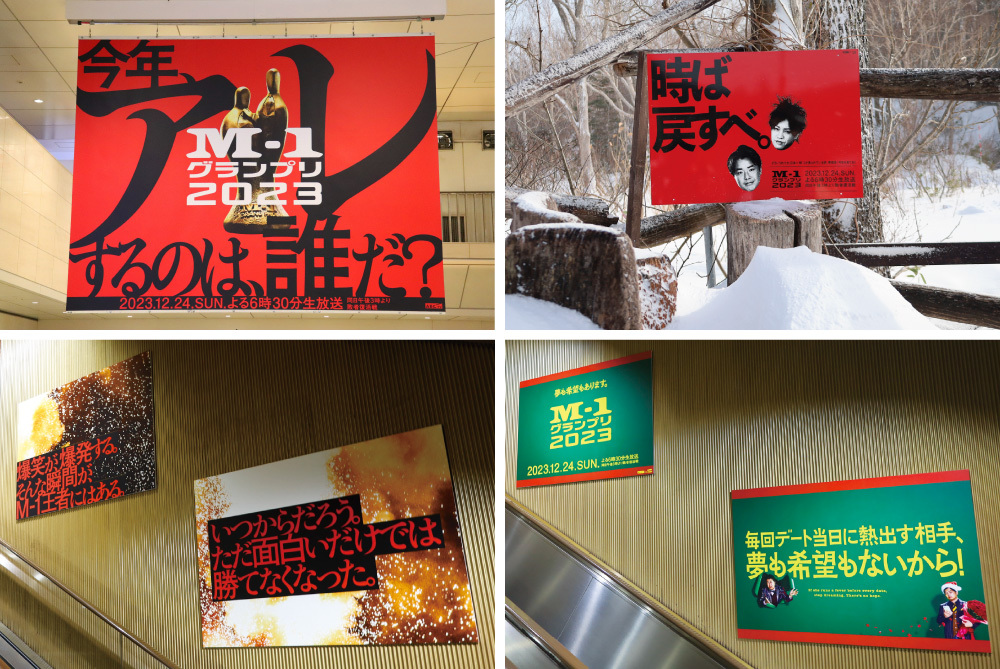Continuing from the previous article, this piece focuses on "Step 1: eXplore." Yuri Nakagawa of X interviewed Sayaka Arimoto, Creative Director at Dentsu Inc., who handled promotions for the M-1 Grand Prix (hereafter M-1) and Korean Netflix dramas, about "how to discover target insights using X."


Examples of 2023 M-1 advertising materials. Clockwise from top right: ① Poster displayed in Aomori Prefecture, which had the highest viewership ratings among all prefectures the previous year. ②③ Posters inside Roppongi Station. ④ Poster at Osaka's Umeda Station.
Nakagawa: How does X help when considering M-1 promotions?
Arimoto: M-1's popularity grows every year, and X gathers many posts from viewers and contestants. Among entertainment content, it's rare to find a platform where performers regularly share updates during the event itself. X lets us see the genuine thoughts of the content's main stars in real time, making it a really interesting medium for M-1.
Nakagawa: I see. How do you utilize X in the early planning stages to uncover target audience insights?
Arimoto: For M-1 promotions, we look back at the previous year's excitement and overlay this year's theme on top of that. For advertising materials like posters, we feature the previous year's champion prominently. This also aims to remind fans of the context and fervor surrounding last year's tournament.
Before planning, we review past posts because last year's tournament buzz is packed with conversation starters on X. We brainstorm how to repurpose those trending topics so fans will want to talk about them in next year's promotion.
Nakagawa: It feels like the planning resonates with the fans, doesn't it?
Arimoto: Posts that generate more engagement aren't just official account posts; many also feature fans cleverly chiming in, like in a comedy contest. So the M-1 movement is truly a collaborative effort with our fans. Fans who post on X are, in a way, co-creating the campaign and are vital to building excitement for M-1.
It's difficult to search through all the previous year's posts once we're in the planning stage, so I always bookmark posts that catch my eye. For example, the 2021 promotion featured last year's winners, Magical Lovely, as the main act. Their winning routine was "Tsurikake," where Crystal Noda rolled around on stage. When Magical Lovely performed "Tsurikake" at Saitama Super Arena in May 2021, Noda posted an image showing his back was incredibly dirty. The moment I saw it, the poster image popped into my head.
Nakagawa: So it's the accumulation of what you see on X day-to-day that takes shape, right?

Nakagawa: In terms of exploring fan insights, what other benefits does X offer?
Arimoto: We also use X to gauge the public sentiment toward M-1 as content—to understand what people feel about M-1. Fundamentally, I'm a huge M-1 fan myself. When I first started this job, my approach was to blend my own fan perspective with the client's vision when planning projects. But as M-1 grew into a major content phenomenon, I realized fans have diverse feelings. I now strive to consider as many opinions as possible when planning promotions.
Nakagawa: How do you perceive M-1 fans on X?
Arimoto: More than fans of the M-1 content itself, there are many fans of individual comedians. Each comedian has a different approach to M-1. Consequently, fans also have their own distinct perspectives on M-1.
Also, because M-1 is manzai performed within the limited time of four minutes, it has become somewhat like a sports competition where each comedian showcases their polished material. Precisely because of this, a sense of tension and life-or-death human drama emerges, and I believe that is also one of M-1's values.
However, some comedians and comedy fans don't want "emotion" and "laughter" to coexist. While we want to increase the number of people who like M-1, we also try not to dismiss the values of those who dislike it.
Nakagawa: Not just with M-1, but with any content, the ideal isn't forcing your liking onto others. It's about skillfully bringing out people's feelings toward the content, so they spontaneously gather around it thinking, "I kinda like this." That said, even when clients ask us to "come up with something for the fandom," I feel the difficulty you mentioned, Arimoto-san, of dealing with the fact that there are all kinds of fans.
Arimoto: The M-1 staff are truly amazing. Everything is comedian-first. They genuinely want to shine a light on every comedian sincerely committed to M-1 and manzai, and they sincerely wish for as many acts as possible to succeed. That's why they closely follow the long journey to the finals with cameras. We believe we should create promotions with the same stance, always facing the performers—the comedians themselves. I feel that's what builds trust with the fans.
Nowadays, many people use X, and within that space, fans post various things, creating excitement and making that passion visible. That peak of passion can even pique the interest of people who weren't interested before. How to get more people talking and make that passion explode is crucial, especially in content promotion. The more fan voices gather, the more visible that passion becomes, and I believe that's how something can grow into a national phenomenon.
Nakagawa: Typically, the larger the content, the coarser the insights become, or they tend to get patterned. Even if you tell fans, "Post with the hashtag," they won't just post anything and everything. Listening to Mr. Arimoto, I feel that even though M-1 is already huge content, it's precisely because you meticulously observe what fans truly want that you can create motivation for them to speak up.
Discovered the insight: "Korean drama fans are skilled at verbalizing their thoughts, like columnists."
Nakagawa: Next, please tell us about Netflix's Korean drama promotion campaign, "#WhyAmIAddictedToKoreanDramas." What kind of initiative was it?
Arimoto: The client was Netflix, and their brief was to reinforce the image that "Netflix is synonymous with Korean dramas." The titles were specified by them, so we ran OOH (out-of-home) ads at Shinjuku Station featuring nine popular Korean dramas that had just started streaming at the time, including "Even If I Know," "The Smart Doctor Life," and "Cha-Cha-Cha and the Sea Street."
Arimoto: We had fans write their reasons for getting hooked on Korean dramas on sticky notes using a generator, then collected them on X under the hashtag "#WhyAmIAddictedToKoreanDramas." We physically printed those notes and plastered them all over a giant poster. As a thank-you to fans, we added a feature: scanning the poster in AR mode revealed video messages from the cast. We also hid sticky notes written by the cast members themselves within the video.
Nakagawa: That's quite impactful. What user insights did you discover on X when planning this promotion?
Arimoto: The promotion aimed to increase social media engagement. While analyzing X to understand how to boost engagement, we noticed Korean drama fans are incredibly vocal and articulate—many write column-like reviews. However, they aren't all famous influencers; they were primarily posting their thoughts rather than targeting large followings. This led us to wonder: Could we amplify these reviews to reach non-viewers and promote Korean dramas? That was the starting point for the project. For the promotion, we developed the hashtag "#WhyAmIAddictedToKoreanDramas" and launched a campaign on X.
The ad visuals were inspired by K-POP fan support ads. I love K-POP and knew about the culture where fans stick Post-it notes on agency buildings or ads for their idol's anniversary. I thought this visual would be surprising even to people uninterested in K-POP, so I wondered if we could leverage that. I felt ads need to evoke surprise or a sense of incongruity to really grab people's attention.
Nakagawa: So the mechanism is: create buzz on X, spread it to the public via OOH, the OOH becomes a topic, boosting X activity again, ultimately increasing overall conversation volume.
Arimoto: When we planned the promotion, we were still deep in the pandemic. Korean drama fans couldn't travel to Korea for pilgrimages or to meet their idols. But their reactions to the drama were overflowing with passion. I sensed an insight: they wanted to convey that passion to the actors and production team. Simply asking fans to post with a hashtag wouldn't have gotten them on board. I believe it was the expectation that "my thoughts might actually reach the actors, like a support ad?" that made them willing to use the slightly more involved generator to participate.
Nakagawa: I see. Korean dramas are more recognized now than a few years ago, so the approach might be different these days. Like with M-1, we need to keep in mind that user insights change depending on the stage of content development.
X, where people's emotions explode, is a treasure trove of creative inspiration
Nakagawa: We've heard about M-1 and Korean dramas, but as an advertising planner, how do you typically utilize X?
Arimoto: I spend a lot of time on X even in my personal life. It feels like a newspaper or weekly magazine that lets me check what's happening in the world, but also like a library overflowing with authentic information.
What's unique about X, compared to platforms like Instagram or Facebook, is that it feels like a social network with very few limits on the emotion of "anger." For example, Instagram posts often aim to present a slightly better version of oneself. In contrast, on X—perhaps because anonymity is commonplace—I really feel there are so many people whose emotions are exploding. I'm interested in "what makes people angry and how that anger subsides," and I see X as a place where the PDCA cycle of human emotions can be observed.

Nakagawa: Do people's negative emotions offer hints for creating ads?
Arimoto: I fundamentally believe ads are generally disliked, so when I create them, I'm careful to avoid triggering too much negative feedback. In that context, X is incredibly valuable for learning about points of anger or sadness. It's fascinating to see people's emotions that surveys often struggle to visualize – things like, "Oh, people get hurt by this?"
Nakagawa: Some companies avoid X because of the high volume of negative feedback. But for those creating ads, it provides an opportunity to think about why these reactions occur, right?
Arimoto: If you try to cater to absolutely everyone and become overly cautious, you can't create interesting ads. But I do want to be considerate to those who see the ads. Using insights gained from X, you can incorporate disclaimers into your message to address feelings, or consider the media and timing for your release. I feel like X offers a lot of methods for avoiding hurting people.
Nakagawa: Besides the emotion of "anger," what other user insights have you gained from X?
Arimoto: When looking at X, I also frequently see posts expressing gratitude for someone's kindness or sharing heartwarming everyday moments. Like posts about how, during a traffic jam, the driver in front showed their stuffed animal to entertain a child. X is full of these little coincidences of daily life. In ad creation, it's incredibly difficult to figure out how to tickle people's feelings of happiness or joy. We learn a lot from X about what truly strikes a chord with people.
Nakagawa: It's about knowing where to press to trigger people's emotions, isn't it?
Arimoto: Especially when depicting slices of life in commercials, a small touch can drastically change the impression of the footage. Furthermore, advertising hinges on how well you capture the spirit of the times while creating something not yet seen in other ads. I often bookmark posts on X that inspire me. Recently, I saw footage of a dog wearing a 360-degree camera. Its sheer cuteness and the novelty of the view from its perspective made me stop scrolling through my timeline. I thought, "This could be useful for a project."
Nakagawa: Hearing your insights today, I understand that rather than turning to X after the project's broad outline is set, utilizing X from the initial planning stages leads to projects that better engage the target audience. Thank you for today.



















